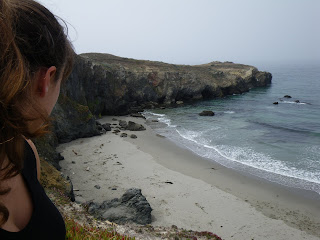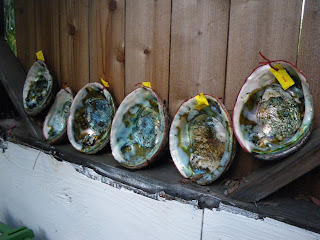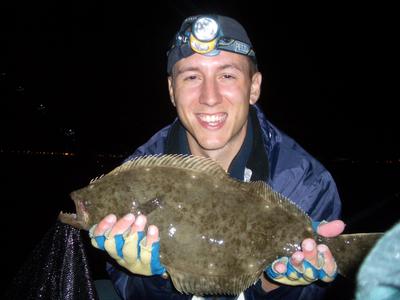I thought it would be worthwhile to describe the introduction Mark and I had to fishing in the ocean from a kayak, as it is a remarkable example of the naïve enthusiasm, the reluctance to spend money, and the sometimes stupid persistence that characterize a lot of our endeavors. I imagine that people who carefully research an undertaking before acting and then spend the money to get high-quality gear that is well-suited to the task at hand probably have more success, but I bet they don’t have as many amusing stories to tell. And they probably don’t get to meet as many rescue personnel.
After reading a few websites in the early spring about kayak fishing we decided that it was something we needed to get into, and fast. Unfortunately we soon discovered that a new tandem kayak that was properly outfitted for fishing would cost no less than $1000 and the used market never got much below $600 – way more than we wanted to spend. So when a used tandem came on the market for $250, we overlooked the fact that it had several large cracks in the deck, didn’t look like any of the other kayaks we had seen, and didn’t have any of the rod holders or access hatches that make a kayak a fishing kayak. It had two seats and (allegedly) floated – we were sold.
Trip 1
Still largely ignorant of what we were doing, we took the yak out for our maiden voyage a couple days later off the coast of Encinitas. Armed with only a couple of light spinning outfits and the plastic grubs we had been surf fishing with, we made it out through the surf with little trouble and headed for a patch of kelp we could see about a half-mile offshore. As soon as we got there Mark promptly hooked a smelt – species didn’t matter, we were ecstatic. After an hour or so and probably a dozen more of these baitfish we decided to call the trip a resounding success and head back. Little did we know that we were about to try our hand at the most terrifying part of kayak fishing in the ocean – the re-entry through the surf.
In our ignorance we assumed that once we got close to shore we could just wait outside the breakers until there was a lull and then paddle in to the beach. If a wave happened to catch up with us while we were in the surf zone we figured we could just ride it in. There turned out to be two major flaws in this line of reasoning. First, it is very hard to detect a lull, which we discovered after paddling furiously towards shore when things seemed calm, only to be overtaken by a four-foot wave. Second, a tandem kayak with two adults aboard it does not handle anything like a surfboard. With the large wave approaching from the rear we paddled faster thinking maybe we could outrun it (we were later to learn that this is exactly the wrong thing to do) – we couldn’t. I remember a brief moment as the wave caught us and we really started picking up speed when I thought, ‘this is going to be an awesome ride!’ This moment turned out to be exceedingly brief though, as the large amount of weight in the front of the kayak (Mark) caused the nose of the boat to dig in as the rear was lifted by the wave. The resulting motion looked much like a catapult, with the projectile being the rear passenger (me), and left both of us in the water and our kayak upside-down.
Amazingly enough, the only lost gear from this episode was a pair of sunglasses and the cover for the small access hole in the top of the kayak. We eventually managed to wrestle the boat up onto the beach and then congratulated each other on living through the ordeal. In the coming weeks we came to regard such a violent re-entry as just part of the game, as 4 of our next 6 trips ended similarly. It wasn’t until Mark had the novel idea of discarding our ‘paddle like mad towards shore’ strategy for the apparently well-known to other kayakers strategy of paddling backwards into an oncoming wave, that we started reaching shore still afloat. Kudos, Mark.
Trip 2
After our first trip we decided it would be very beneficial to have places to put several rods while fishing and also a way to stow the rods inside the hull for the surf re-entry. To this end we decided to further compromise the already questionable integrity of the hull by cutting several small holes and one very large hole in the deck. We installed a total of five flush-mount rod-holders in the small holes and fashioned a removable hatch for the large hole using a lot of glue, weather-stripping, and some cam-lock fasteners. We also spent a lot of time, glue, and rivets trying to repair the cracks in the deck, which we had temporarily repaired with duct tape for the first trip. Confident in our newly configured fishing machine, we launched from the same place for trip number two. The fishing was even more successful than the first trip, as we managed to catch a couple bass in addition to the baitfish, and when we left the kelp to head back in our spirits were high. The sizeable chop that the wind had kicked up and the whitecaps that occasionally broke across the boat made paddling rather difficult, but we were kayak fishing and loving it. It wasn’t until we got a little closer to shore and I opened the hatch to stow our gear that I realized we were in trouble. Just as I put the first rod below decks a wave broke across us and I saw a fair amount of water go down the hatch. This made us float a little lower in the water, and before I could get the second rod in another wave added even more water to the inside of our boat. At that point I decided it would be more prudent to re-seal the hatch than worry about stowing gear, but before I could put this new plan into action a third wave put us low enough in the water that the open hatch went underwater and I had to give the order to abandon ship.
Now let me stop right here to say that Mark and I are not as stupid as some of our actions may indicate. Sure we had managed to sink our kayak in only our second outing, but we had taken some precautions to prevent just such a scenario from being truly disastrous. Both of us were wearing wetsuits and lifejackets, and we had put a couple foam swim noodles in the hold of the boat to keep it from going completely to the bottom if it ever got swamped. What we had failed to prepare for was the well intentioned but over-zealous lifeguard rescue squad of the Encinitas/Solana Beach area, who we were about to meet for the first but not last time. As we began kicking the submerged kayak back in towards shore, laughing sheepishly and trying to come up with creative ways to blame the event on each other, we saw the lifeguard truck tearing down the beach in our direction. We prayed that maybe there was a surfer somewhere nearby that was in need of being rescued, but when the truck stopped directly in front of us and the lifeguard did his best David Hasselhoff sprint into the water with his rescue board we realized the situation was about to get a lot more embarrassing.
We could see the disappointment in the lifeguard’s eyes when he made it out to us and realized we weren’t in dire need of rescue. Even though we thanked him for his concern and assured him that we had the situation under control he insisted on staying with us and overseeing our slow progress of kicking the submerged boat through the surf and back to shore. By the time we got there another lifeguard truck and more rescue personnel had shown up, but their interest quickly waned when it became apparent that there wasn’t a lot of rescuing to be done. I tried to get a group photo of all of them for the blog only to discover that this trip had been the last for both my cell phone and digital camera - peanut butter jars are not as waterproof as they seem. Combined with the loss of a tackle box during the less-than-orderly ship-abandonment maneuver this made Trip 2 a costly one.
A couple months later we squandered an even better photo op when our night-time kayaking antics mobilized both the lifeguard community and the Solana Beach Fire Department, but that’s a story for another time.
 I plan on throwing a party to celebrate when I get back from my east coast bidness trip and all the guests (or at least the ones I deem mechanically sound) will get their hand stamped at the door.
I plan on throwing a party to celebrate when I get back from my east coast bidness trip and all the guests (or at least the ones I deem mechanically sound) will get their hand stamped at the door. I plan on throwing a party to celebrate when I get back from my east coast bidness trip and all the guests (or at least the ones I deem mechanically sound) will get their hand stamped at the door.
I plan on throwing a party to celebrate when I get back from my east coast bidness trip and all the guests (or at least the ones I deem mechanically sound) will get their hand stamped at the door.




















